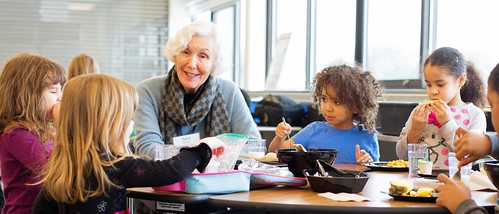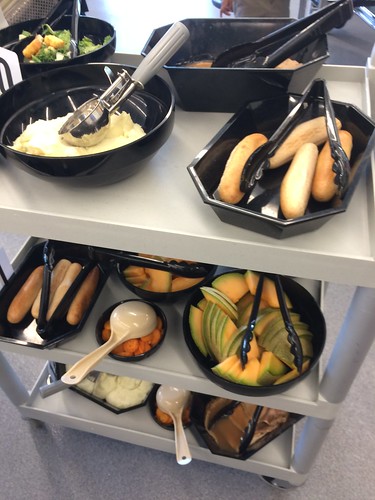
How do you create a better lunch experience for students? It all started with a conversation between Ginger Davis Kranz, Principal of Webster Elementary School, and the Minneapolis Public Schools’ Director of Food Service, Bertrand Weber. In September 2016, I was fortunate enough to visit Webster Elementary School in Minneapolis and see for myself how their family-style dining works. I’d like to share Webster Principal Ginger Davis Kranz’s inspiring blog about her school’s innovative and thoughtful approach to the students’ mealtime experience.
By Ginger Davis Kranz, Principal of Webster Elementary School
What if school lunchtime was more than just a wait in line and a race to find a seat and eat, but instead was more like a traditional family meal – a time when friends gather to enjoy their food, engage in meaningful conversation, build relationships and gain important life skills? After reflecting on this question, Webster Elementary, a Minneapolis public school, made the decision to abandon the typical chaotic and impersonal lunchroom experience and create a family-style dining program.
Our goal was to look at lunch in a different way. We seized the opportunity that lunch can provide students a chance to gain important knowledge, life skills and habits. We reflected on what that would look like and decided to eliminate the lunch line, seat children at round tables where food is served family style, give the children meal responsibilities where they help their peers and maintain the environment and bring teachers, staff and volunteers in the dining hall to join students for the 30 minute lunch. We have found that family-style dining is helping us reach our vision for our students’ lunch experience. Bringing an appreciation of food and where it comes from; an awareness of self and others; an understanding of healthy eating; a calm space for eating, learning and manners; time to eat and socialize in a healthy way; a reduction in waste and students taking responsibility for their meal time.
During the meal, our staff monitors portions and meal pattern requirements, while students take responsibility for themselves and their community by helping to set the table, passing food around, serving themselves and get assigned clean up jobs to restore the environment. The student “table leads” or “hosts” get milk orders from their tables, then pour it into cups and serve to their peers. Water is also available, and students assist in serving their peers that as well. Volunteers encourage healthy eating, sharing conversation, helping each other and taking care of the environment.
The change has been embraced by students, volunteers and staff. Students comment that “I like not having to spend lunch time waiting in line.” Others enjoy having jobs to do. Many beam with pride as they take drink orders and pour the glasses themselves. Our volunteers think this opportunity to connect with students is a treat. They have shared how they are impressed by student conversation skills.
Such a large change does not come without challenges and a need for flexibility to adjust along the way. Gaining support from building staff and food service was critical, as well as carefully observing, listening to feedback and making changes to ensure the process works for everyone. Since we started last January, we continue to tweak the process, but overall, it has been well received by students, families and the community. Instead of a chaotic, student management problem, our lunchroom is a welcoming community that enriches students and adults alike.

